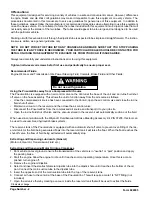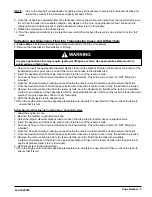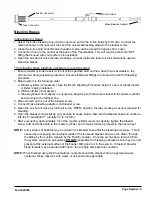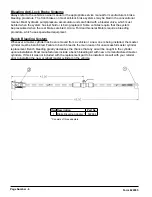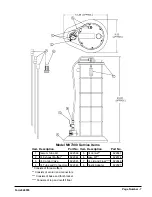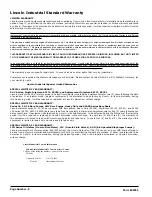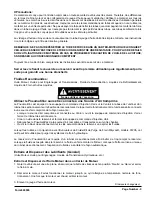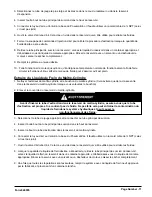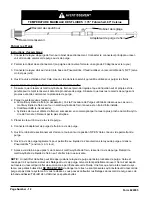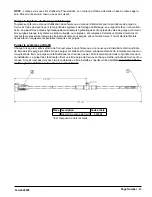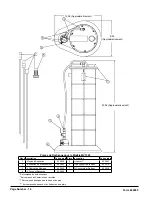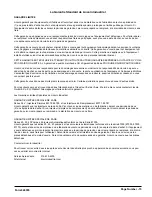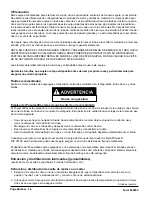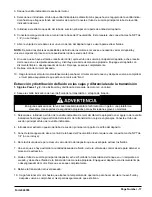
Page Number - 2
Form 824555
©Precautions:
This equipment is designed for servicing a variety of vehicles in a safe and convenient manner. However, differences
in engine blocks and dip stick configurations may make it impossible to use this equipment on every vehicle. The
procedures documented in this manual are to serve as guidelines for general use of this equipment. In addition to
these guidelines, always follow the manufacturer’s recommended procedures when attempting to use this equipment
on each unique vehicle. Do not attempt to force the tubes included with this equipment into a dip stick tube that will
not readily accept the smaller of the two tubes. The tubes would appear to be too large and not designed to be used
with the particular vehicle.
Draining oil with this evacuator unit through the dipstick tube is expected to be simple and straightforward. The instruc-
tions were written as a general guideline only.
NOTE: DO NOT FORCE THE TUBE INTO ANY CRANKCASE AND MAKE SURE THAT YOU STOP PUSHING
THE TUBE IN IF ANY FORCE IS RECOGNIZED. YOUR PARTICULAR DEALER SHOULD BE CONTACTED FOR
DETAIL ON USING THIS EQUIPMENT TO EVACUATE OIL FROM YOUR CAR IF ISSUES ARISE.
Always read carefully and understand instructions prior to using this equipment.
Tighten lid-to-reservoir screws befor first use and periodically to ensure proper seal.
Recommended Fluids:
Engine Oil, Gear and Transmission Oils, Power Steering Fluid, Coolants, Brake Fluid and Other Fluids.
Do not use with gasoline.
Using the PneumatiVac away from a Compressed Air Source
The PneumatiVac is equipped with an air control valve on the Venturi at the base of the unit and an in-line fluid shut
off valve on the hose assembly. This allows the unit to function away from the air source as follows:
• Once the compressed air source has been connected to the Venturi, open the air control valve and close the in-line
fluid shut off valve.
• Maintain a vacuum in the reservoir and then close the air control valve.
• Disconnect the PneumatiVac from the compressed air source and transport it to your job site.
• Open the in-line fluid shut off valve and the vacuum stored in the reservoir will automatically suction out the fluid.
When used in conjunction with the Mityvac® Fluid Evacuator Brake Bleeding Accessory Kit, PIN 07205, this tool can
be used to vacuum bleed hydraulic brake systems.
The reservoir tank of the Pneumativac is equipped with an automatic shut-off valve to prevent over-filling of the res
-
ervoir tank. As the fluid being evacuated flows into the reservoir tank it will raise the float. When the float reaches the
shut-off valve, the flow of fluid being extracted will automatically stop.
Extracting and Dispensing Lubricants (General)
(Motor oil, Gear Oil, Transmission Fluid, etc.)
Extracting and Dispensing Motor Oil into a Crankcase
1. Park vehicle on level ground, ensure the transmission of the vehicle is in “neutral” or “park” position and apply
the parking brake.
2. Start the engine. Allow the engine to idle until it reaches normal operating temperature. Once this is accom-
plished, turn engine off.
3. Remove the engine oil dipstick.
4. Select and insert the smallest diameter dipstick tube into the dipstick hole until it reaches the bottom of the oil
pan. Connect the main suction tube to the dipstick tube.
5. Insert the opposite end of the main suction tube into the top of the reservoir tank.
6. Connect air hose to the venturi at the base of the PneumatiVac. This will require a male 1/4” NPT fitting (not
included).
7. Open the air valve thereby creating a vacuum inside the reservoir tank that will be used to extract the fluids.
© Indicates change


